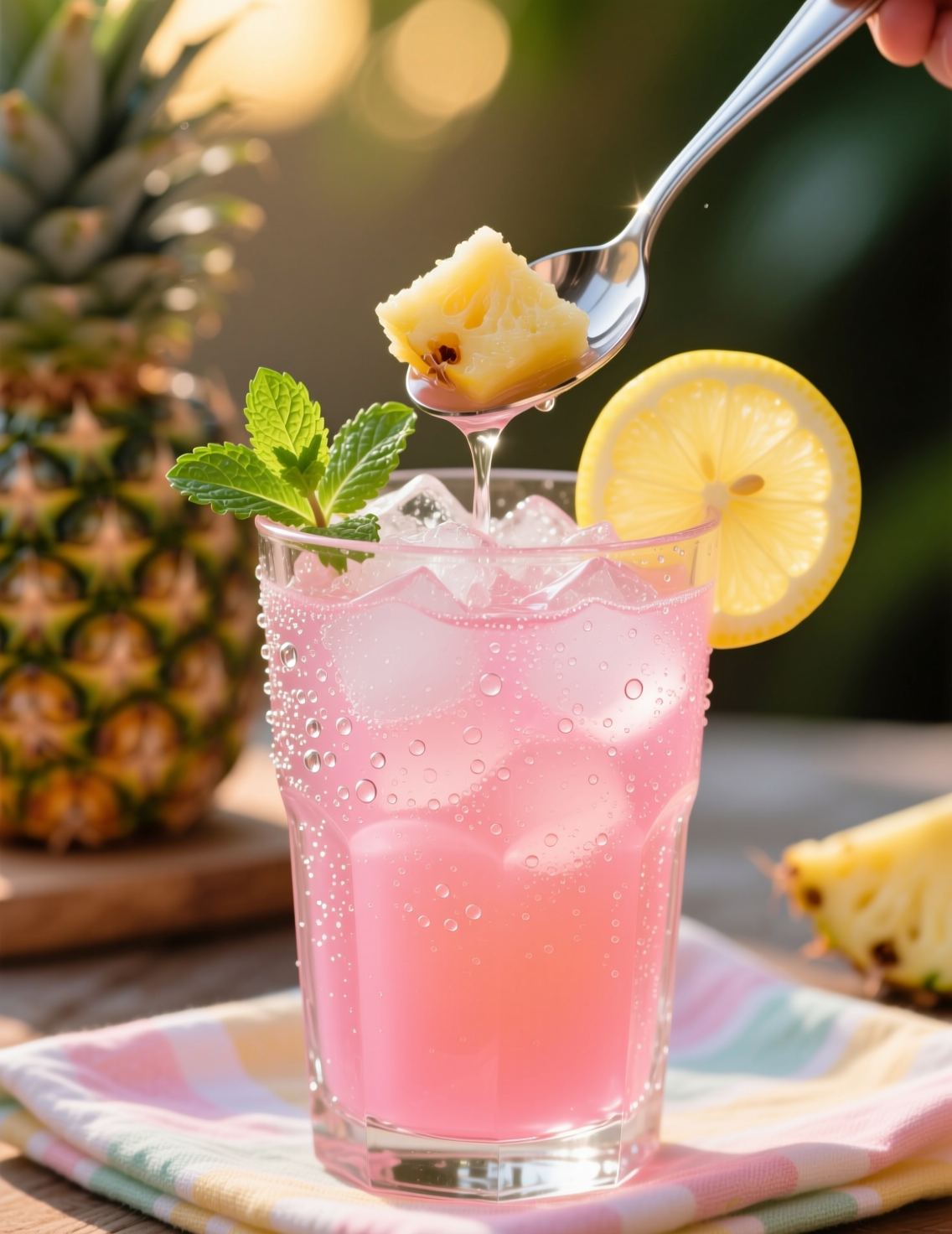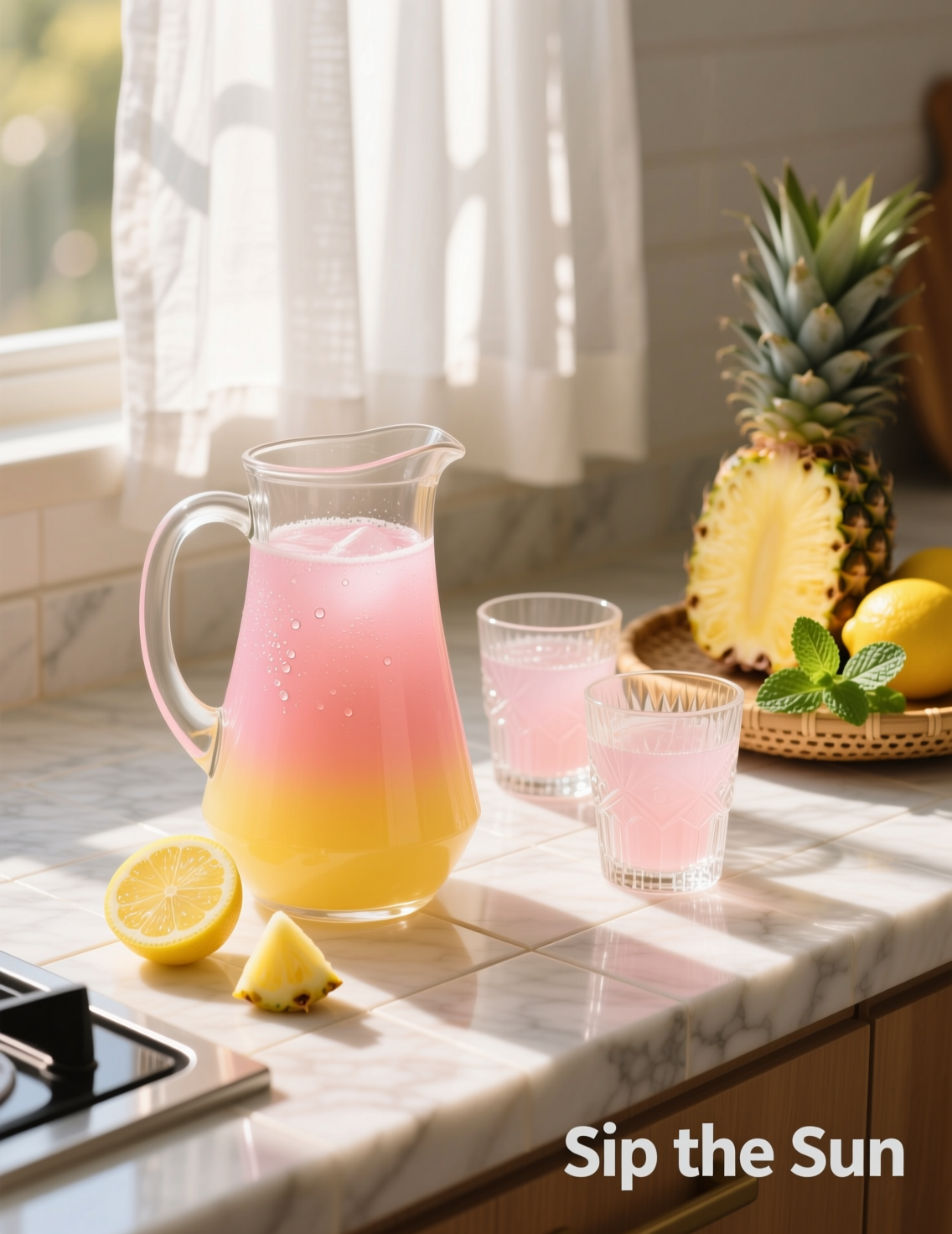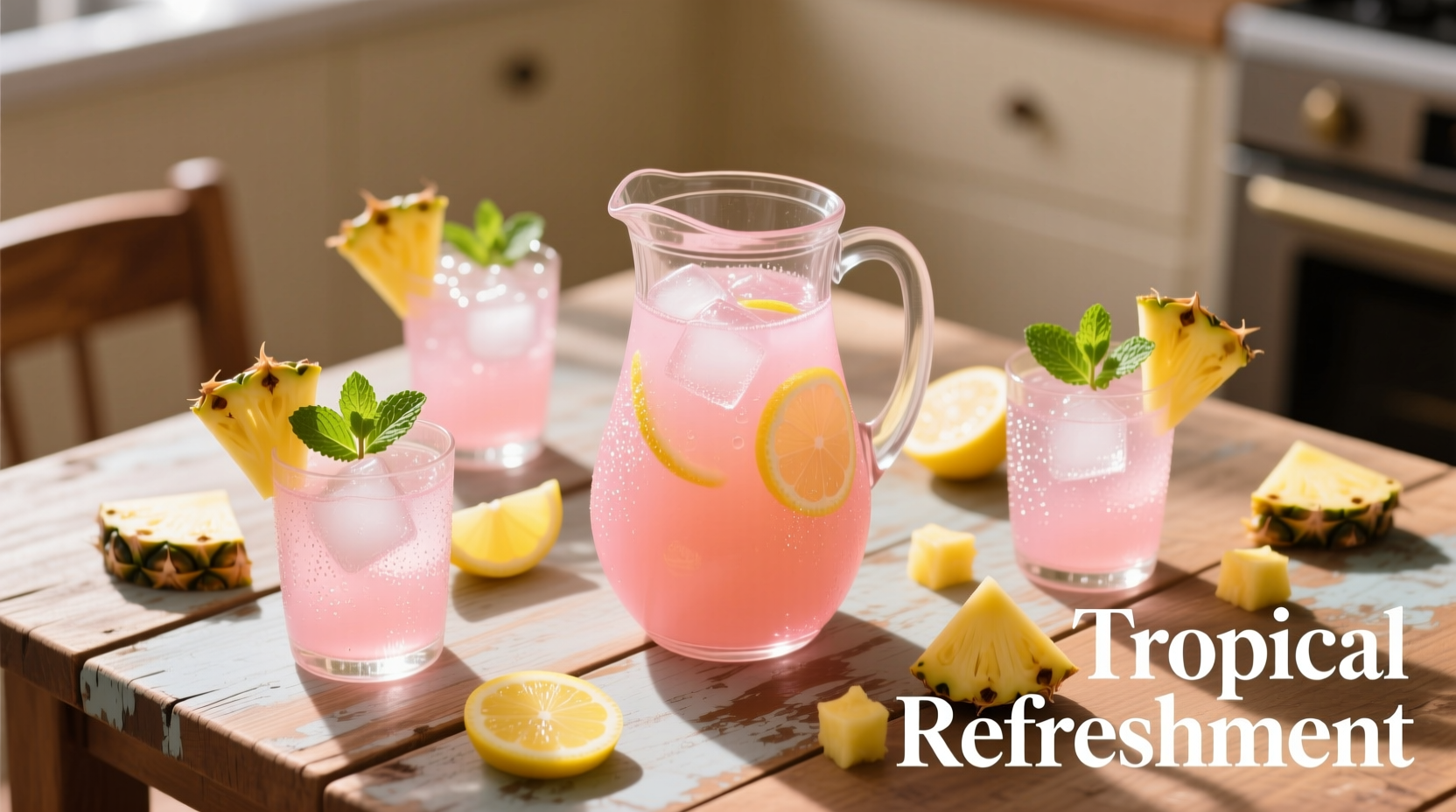There are drinks that come and go with the seasons, and then there are drinks that feel timeless. Pineapple pink lemonade is one of those rare blends that sits quietly on both lists—it feels classic, yet it still surprises people every time they sip it. It’s not just a sugary summer punch; when done well, it’s an elegant beverage layered with tartness, natural sweetness, and tropical flair. In this article, I’ll walk you through everything from crafting the perfect recipe to exploring its variations, nutritional profile, and why professionals in kitchens and bars should pay more attention to this underestimated drink.
Why Pineapple Pink Lemonade Deserves Attention
Pink lemonade has always carried a little mystery. Some say it was created by accident in the 19th century when a circus vendor dyed lemonade with cinnamon candy. Others insist it was tinted using crushed berries. Whatever its true beginning, pink lemonade stuck because it felt more playful than ordinary lemonade.
Now, add pineapple into the mix. Pineapple brings complexity—an intense sweetness that also has a sharp acidity. Unlike plain lemon or strawberry-based pink lemonade, pineapple adds body and fragrance. It’s the difference between a casual porch drink and something you could easily place on a crafted cocktail menu.
In hospitality, presentation matters as much as taste. A glass of pineapple pink lemonade, chilled with crushed ice and garnished with fresh pineapple wedges or edible flowers, creates visual drama. In catering or mixology, this alone can raise the perceived value of an event’s beverage selection.
The Core Recipe: Building Balance
Every good recipe starts with balance. Lemonade is about acidity and sugar playing off one another, while pineapple brings another layer. Too much pineapple juice and you’ll drown the lemon; too little and it just tastes like someone dropped a pineapple candy in water.
Here’s a professional base recipe:
Ingredients (makes 6 servings):
- 1 cup freshly squeezed lemon juice (about 5–6 medium lemons)
- 1 cup fresh pineapple juice (from ripe fruit, not canned if possible)
- ¾ cup granulated sugar or honey (adjust to taste)
- 4 cups cold water (sparkling works if you want effervescence)
- ½ cup cranberry juice or pomegranate juice (for the pink color)
- Ice cubes, crushed preferred
- Garnishes: pineapple wedges, lemon slices, fresh mint
Method:
- Dissolve sugar in warm water (about ½ cup) to make a quick syrup. This avoids gritty undissolved sugar.
- In a pitcher, combine lemon juice, pineapple juice, and cranberry juice. Stir gently.
- Add syrup, then dilute with cold water until balanced to taste.
- Chill for at least 30 minutes in the refrigerator. This resting step allows flavors to mellow and integrate.
- Serve over ice, garnished as desired.
Notice the cranberry juice. It’s not just for color—it contributes tannins and light bitterness, which help cut through the sweetness of pineapple. Professional kitchens know this: color and flavor must work in tandem.

Professional Tips for Flawless Results
Freshness isn’t negotiable. Bottled lemon juice can ruin this drink with flat acidity. Always squeeze lemons by hand or use a hand press.
Pineapple deserves special care too. Enzymes in fresh pineapple (bromelain) can sometimes create astringency if left sitting too long. That’s why chilling the mixture for hours isn’t ideal. Prepare it the day it’s served, ideally a few hours before.
As for sweeteners, sugar works, but honey or agave bring floral notes. Professional bartenders often use simple syrup infused with herbs. A rosemary syrup, for example, shifts the drink into a more sophisticated direction.
Variations for Professionals
Pineapple Pink Lemonade Spritz
Swap still water with sparkling mineral water. Serve in stemmed glassware, garnish with edible flowers. This plays well in upscale restaurants where presentation sells.
Pineapple Pink Lemonade Margarita
Blend the base with tequila and triple sec. Rim the glass with chili salt. Suddenly, you’ve moved from brunch-friendly to evening cocktail hour.
Pineapple Coconut Pink Lemonade
Coconut water replaces half the plain water. The result is hydrating, slightly creamy, and perfect for tropical menus.
These variations demonstrate versatility. For professionals, one base recipe can generate multiple offerings depending on the event and clientele.
Nutritional Insights and Market Appeal
A 12-ounce serving of homemade pineapple pink lemonade averages about 140–160 calories if made with sugar. But nutrition isn’t just about calories. Pineapple contributes vitamin C, manganese, and small amounts of B vitamins. Lemon juice adds potassium and more vitamin C.
From a market standpoint, people increasingly seek beverages that feel indulgent but aren’t overly processed. Pink lemonade from powdered mixes has a reputation for being artificial. A freshly made pineapple pink lemonade, however, taps into the clean-label trend. According to a 2024 Mintel report, 63% of consumers prefer drinks marketed as natural or fresh-squeezed. For businesses, this is an easy win.
Common Mistakes to Avoid
One common mistake is oversweetening. Because pineapple is already high in natural sugars, recipes that pile on extra sugar can feel cloying. Always taste-test before adding the full amount of sweetener.
Another misstep: using dull ice. Cloudy or freezer-burnt ice can literally taste stale and ruin the clean brightness of lemonade. In professional service, bartenders use clear ice or crushed pebble ice for both taste and aesthetic.
Also, skipping the acid balance. Pineapple alone doesn’t replace lemon—it enhances it. Without fresh lemon juice, the drink falls flat.
Answering the Big Questions
Why pink and not just pineapple lemonade? Because color influences perception. People expect pink lemonade to taste fun, slightly fruity, and festive. It creates anticipation before the first sip.
Can you batch this for events? Yes, but only up to a day ahead. Keep juices and syrup separate, then combine right before service to avoid fermentation-like off flavors.
Can you make it sugar-free? Absolutely. Use stevia or monk fruit. However, professionals should be cautious—these sweeteners sometimes leave aftertastes that clash with pineapple.
Beyond the Recipe: Cultural and Emotional Value
Pineapple pink lemonade isn’t just about quenching thirst. It carries emotional weight. The color pink often symbolizes celebration, joy, even nostalgia. Add pineapple and you’re layering in the exotic, the idea of escape. In weddings, summer festivals, and resort menus, this emotional dimension drives choice.
In professional kitchens, beverage programs increasingly focus on storytelling. A pineapple pink lemonade can be framed not as a “child’s drink,” but as a bridge between classic Americana and tropical sophistication. That’s the angle that wins over discerning guests.
Emerging Trends in Beverage Innovation
Looking ahead, functional ingredients are gaining ground. Imagine adding ginger for digestion, chia seeds for texture, or turmeric for anti-inflammatory benefits. Pink lemonade is an easy canvas for such innovation.
Another trend is low-ABV cocktails. Pineapple pink lemonade can be gently spiked with Aperol, rosé wine, or sake, offering sophisticated yet lighter alternatives to heavy cocktails.
In sustainability terms, many chefs use the leftover pineapple rinds to make a lightly fermented tepache-like base. This not only reduces waste but adds complexity to the lemonade’s flavor.

Conclusion: The Craft Behind the Glass
At its best, pineapple pink lemonade is more than just juice and sugar. It’s a crafted balance of acid, sweetness, and color that plays beautifully in both casual and professional settings. For chefs, caterers, and bartenders, it offers a flexible template—simple enough for fast service, complex enough for creative adaptations.
The key lessons? Respect the balance of flavors, use only fresh ingredients, and treat presentation as essential, not optional. For businesses, highlight its freshness and natural color to tap into consumer demand. For home professionals, experiment with herbs, sparkling water, or spirits.
The next time someone asks for pink lemonade, don’t just pour the ordinary. Serve pineapple pink lemonade, and watch how quickly the glass empties. That, after all, is the real proof of a recipe done right.
FAQs
What makes pineapple pink lemonade different from regular pink lemonade?
It combines pineapple’s tropical sweetness with the tartness of lemon and a hint of cranberry for color and depth.
Can I use canned pineapple juice for this recipe?
Yes, but fresh pineapple juice gives brighter flavor and a cleaner finish.
How do I keep it from being too sweet?
Adjust the sugar gradually and balance with enough lemon juice for acidity.
Can pineapple pink lemonade be made ahead of time?
Yes, but mix juices and syrup just before serving to avoid dull flavors.
What can I use to make it pink besides cranberry juice?
Pomegranate juice, raspberry puree, or even hibiscus tea can add natural color.
Is pineapple pink lemonade healthy?
It’s rich in vitamin C and minerals, but the sugar content should be moderated.
Can it be turned into a cocktail?
Yes, adding tequila, vodka, or sparkling wine makes an excellent adult version.
How do I make it more refreshing for summer parties?
Serve over crushed ice with mint and chilled glassware for maximum freshness.
What’s the best garnish for presentation?
Pineapple wedges, lemon slices, or edible flowers add elegance and color.
Can I make it sugar-free?
Yes, sweeten with stevia, monk fruit, or agave for a lighter option.

Mariana is a passionate home cook who creates delicious, easy-to-follow recipes for busy people. From energizing breakfasts to satisfying dinners and indulgent desserts, her dishes are designed to fuel both your body and hustle.
When she’s not in the kitchen, she’s exploring new flavors and dreaming up her next recipe to share with the Foodie Hustle community.

